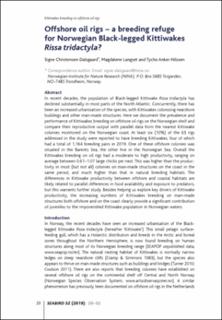Offshore oil rigs – a breeding refuge for Norwegian Black-legged Kittiwakes Rissa tridactyla?
Peer reviewed, Journal article
Published version

Åpne
Permanent lenke
https://hdl.handle.net/11250/2686559Utgivelsesdato
2020Metadata
Vis full innførselSamlinger
- Publikasjoner fra CRIStin - NINA [2397]
- Scientific publications [1423]
Originalversjon
Seabird. 2020, 32 20-32.Sammendrag
In recent decades, the population of Black-legged Kittiwake Rissa tridactyla has declined substantially in most parts of the North Atlantic. Concurrently, there has been an increased urbanisation of the species, with Kittiwakes colonising nearshore buildings and other man-made structures. Here we document the prevalence and performance of Kittiwakes breeding on offshore oil rigs on the Norwegian shelf and compare their reproductive output with parallel data from the nearest Kittiwake colonies monitored on the Norwegian coast. At least six (10%) of the 63 rigs addressed in the study were reported to have breeding Kittiwakes, four of which had a total of 1,164 breeding pairs in 2019. One of these offshore colonies was situated in the Barents Sea, the other five in the Norwegian Sea. Overall the Kittiwakes breeding on oil rigs had a moderate to high productivity, ranging on average between 0.61–1.07 large chicks per nest. This was higher than the productivity in most (but not all) colonies on man-made structures on the coast in the same period, and much higher than that in natural breeding habitats. The differences in Kittiwake productivity between offshore and coastal habitats are likely related to parallel differences in food availability and exposure to predators, but this warrants further study. Besides helping us explore key drivers of Kittiwake productivity, the increasing numbers of Kittiwakes breeding on man-made structures both offshore and on the coast clearly provide a significant contribution of juveniles to the impoverished Kittiwake population in Norwegian waters.